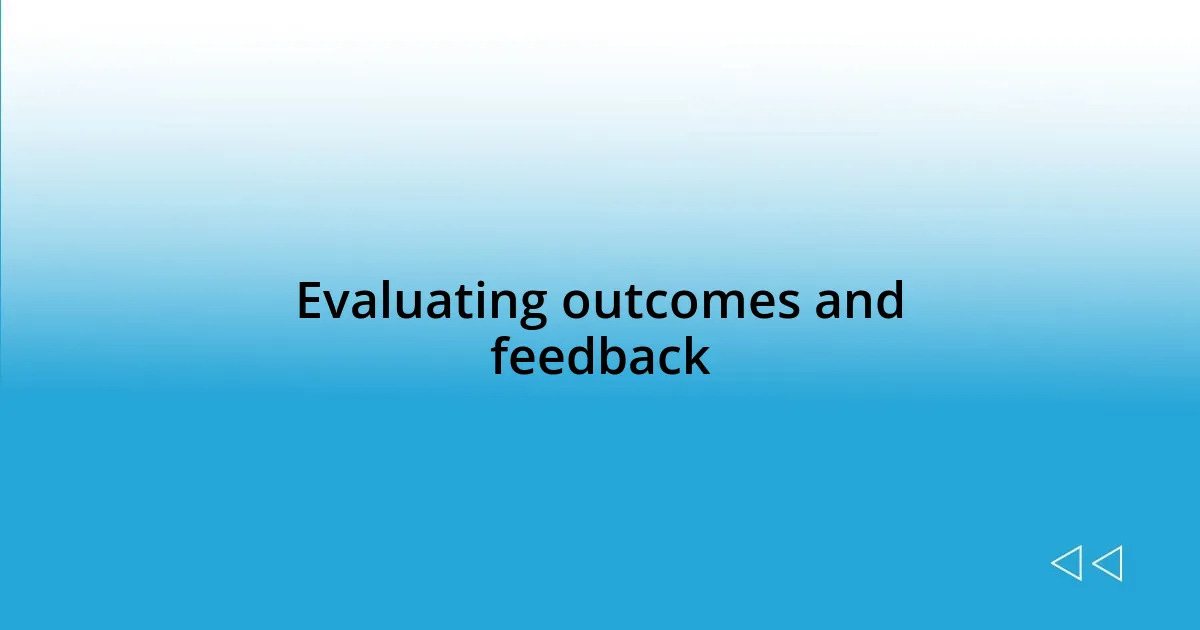Key takeaways:
- Cultural competence requires ongoing reflection and adaptation to create a trusting therapeutic environment where clients feel understood and valued.
- Tailoring interventions based on clients’ cultural values enhances communication and leads to more effective treatment outcomes.
- Building trust is crucial for therapy; it involves authenticity, deep listening, and respecting cultural practices to encourage client vulnerability.
- Client feedback is essential for growth and effectiveness, allowing therapists to adapt their approaches and enhance the therapeutic experience.

Understanding cultural competence
Cultural competence in therapy is more than just understanding different backgrounds; it’s about connecting with clients on a deeper level. I remember a session where a client from a distinct cultural heritage expressed feelings of alienation. It struck me how vital it is to both acknowledge their experience and incorporate their cultural context into our work together.
When I first delved into cultural competence, I realized it requires ongoing reflection and learning. It’s not a checkbox to tick off but a continuous journey that broadens my perspective. Have you ever had an encounter that challenged your assumptions? I certainly have, and those moments have been pivotal in shaping my approach.
Cultural competence enables therapists to create a safe, trusting environment. Clients often share that they feel more understood and valued when their cultural identities are recognized. This personal acknowledgment can lead to breakthroughs, as it invites clients to be their authentic selves without the fear of being judged.

Importance of cultural awareness
Cultural awareness in therapy is fundamentally important because it shapes the therapeutic alliance. When I worked with a client from a different cultural background, we faced communication barriers that, at first, felt daunting. Yet, once I made an effort to understand their values and norms, our sessions blossomed into a collaboration rather than just a clinical interaction.
Furthermore, cultural awareness empowers therapists to customize their interventions. For instance, I recall adjusting my approach for a client who placed significant importance on family dynamics. By involving their family in the therapeutic process, I was able to honor their cultural values, which ultimately led to more effective outcomes. It’s fascinating how these tweaks in approach can transform the therapeutic experience.
Finally, neglecting cultural awareness can lead to misunderstandings and misinterpretations. One time, I misread a client’s nonverbal cues due to cultural differences, which momentarily created tension in our session. This experience reminded me just how crucial it is to engage in active listening and ask questions rather than making assumptions. Being culturally aware transforms challenges into learning opportunities.
| Cultural Awareness Benefits | Consequences of Ignoring Cultural Awareness |
|---|---|
| Enhances therapeutic alliance | Creates misunderstanding and mistrust |
| Enables tailored interventions | Leads to ineffective treatment |
| Encourages open communication | Challenging client-therapist dynamics |

Building trust with clients
Building trust with clients is one of the cornerstones of effective therapy. I’ve found that trust is cultivated through consistent authenticity and transparency. For instance, I once had a client who was hesitant to share their struggles at first. It became clear that providing them with a safe space—where I openly acknowledged my own uncertainties—was instrumental in our progress. Seeing their body language shift from guarded to open was a reaffirmation of how trust takes time but is absolutely worth the effort.
- Listening deeply and without interruption shows clients that I value their narratives.
- Sharing relevant parts of my own experiences can help bridge the gap between us.
- Regular check-ins about their comfort level in therapy ensure a collaborative relationship.
- Honoring cultural practices, such as making space for traditional healing, reinforces respect and trust.
When I focus on building trust, I can’t help but notice that clients tend to be more honest about their experiences. It allows for vulnerability, which I believe is the gateway to genuine healing. Engaging with clients on a level where they feel seen motivates them to explore their feelings and situations more openly.

Adapting therapeutic approaches
Adapting therapeutic approaches is essential for creating meaningful connections with clients from diverse backgrounds. I remember working with a young woman from a community with unique communication styles. Initially, our sessions felt stilted, but when I shifted to a more metaphorical way of discussing her experiences, something magical happened. Suddenly, the language barrier lifted, and she illuminated profound insights about her life that had once been locked away.
It’s often in the small adjustments that I find the most significant breakthroughs. For instance, integrating cultural storytelling into our sessions made her feel more understood and validated. Reflecting on her narrative, I realized that I wasn’t just helping her cope but enabling her to reclaim her story on her terms. Isn’t it remarkable how tweaking the way we communicate can unlock deeper healing?
Flexibility in therapeutic techniques is also vital for fostering a safe environment. I recall a case where a client was more comfortable with art therapy than traditional talk therapy. By embracing her artistic expressions, I not only validated her preferred method of communication but also facilitated a deeper exploration of her emotions. This experience reiterated the notion that therapy isn’t one-size-fits-all; it’s a journey where each client deserves to navigate their path uniquely.

Navigating cultural differences
Navigating cultural differences in therapy can be a delicate dance. I remember a session with a bilingual client who often switched between languages, reflecting their cultural influences. Instead of feeling frustrated by the shifts, I leaned into the fluidity, allowing our conversation to flow more naturally. It was enlightening—opening the door to insights that transcended mere words and highlighting how embracing these nuances can create a richer therapeutic experience.
Cultural contexts shape how clients express their feelings and concerns. One day, I worked with a client who used humor as a way to cope with deep pain—what initially seemed like a barrier turned out to be a bridge. By using humor in our discussions, I found common ground, which led to deeper conversations about their struggles. This experience taught me that understanding clients’ cultural lenses could transform potential misunderstandings into meaningful dialogue.
It’s fascinating how navigating cultural differences requires continuous learning. In one instance, I observed a client’s hesitation towards discussing certain topics due to cultural taboos. Instead of pushing, I created a safe space by gently revisiting those topics at a later time—when they were ready. Isn’t it amazing how patience and respect can foster openness? This approach not only nurtured trust but reinforced my belief that therapy thrives on adaptability, allowing clients to reclaim their narratives in ways that resonate with their cultural identities.

Implementing inclusive practices
Implementing inclusive practices in therapy is not just a concept; it’s an evolving commitment that teaches us as practitioners every day. I vividly recall a moment when I decided to incorporate traditional rituals from my client’s cultural background into our sessions. It felt a little unconventional at first, but the warmth and openness that followed were undeniable. Clients often flourish when they feel safe to share their cultural practices—it’s incredible how these elements can serve as powerful therapy tools.
I’ve also learned the importance of actively seeking feedback from clients about their experiences in the therapeutic process. For instance, during a session, I asked one client how she felt about our current approach. Her response was enlightening, revealing her desire for more collaborative discussions about her cultural identity. This exchange not only empowered her voice but also helped me tailor my techniques to better match her needs—do we sometimes underestimate the power of a simple question?
On another occasion, I organized group therapy sessions that celebrated cultural differences among participants. The atmosphere was electric—there was laughter, sharing, and even surprise at the similarities that emerged. I couldn’t help but think of how these moments of connection reflect the very essence of therapy. When we honor each participant’s cultural narrative, inclusivity becomes a practice rather than a checkbox, enriching the healing journey for everyone involved.

Evaluating outcomes and feedback
Evaluating outcomes in therapy extends far beyond merely tracking progress; it’s about genuinely understanding the client’s transformation. I recall a session where I asked a client to summarize their feelings after we tried new techniques grounded in their cultural context. Their response, filled with relief and excitement, underscored how essential it is to measure success through their lens, not just outcomes on paper. Isn’t it fascinating how a simple question can unveil the depth of a client’s journey?
Feedback is an invaluable tool for growth, not only for clients but also for therapists. I learned this during a particularly revealing feedback session where a client expressed how certain approaches made her feel alienated rather than seen. Hearing this stung at first, but I realized it was an opportunity to reevaluate my methods. How can we improve if we’re not willing to listen?
After implementing changes based on client feedback, I began to notice shifts in engagement and openness. One client, who once struggled to express herself, started sharing vivid stories connected to her cultural heritage. It was as if a door had swung open. This experience reaffirmed my belief that inviting client input creates a collaborative environment, ultimately enhancing the therapy’s effectiveness. Isn’t that what we aim for—a shared space for healing?














